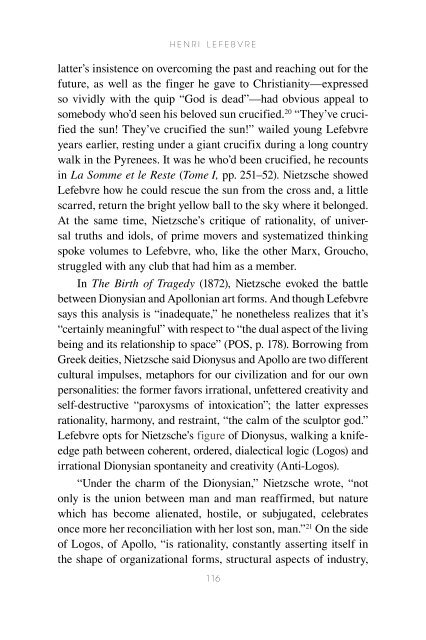Henri Lefebvre: A Critical Introduction - autonomous learning
Henri Lefebvre: A Critical Introduction - autonomous learning
Henri Lefebvre: A Critical Introduction - autonomous learning
You also want an ePaper? Increase the reach of your titles
YUMPU automatically turns print PDFs into web optimized ePapers that Google loves.
H e n r i L e F e b v r e<br />
latter’s insistence on overcoming the past and reaching out for the<br />
future, as well as the finger he gave to Christianity—expressed<br />
so vividly with the quip “God is dead”—had obvious appeal to<br />
somebody who’d seen his beloved sun crucified. 20 “They’ve crucified<br />
the sun! They’ve crucified the sun!” wailed young <strong>Lefebvre</strong><br />
years earlier, resting under a giant crucifix during a long country<br />
walk in the Pyrenees. It was he who’d been crucified, he recounts<br />
in La Somme et le Reste (Tome I, pp. 251–52). Nietzsche showed<br />
<strong>Lefebvre</strong> how he could rescue the sun from the cross and, a little<br />
scarred, return the bright yellow ball to the sky where it belonged.<br />
At the same time, Nietzsche’s critique of rationality, of universal<br />
truths and idols, of prime movers and systematized thinking<br />
spoke volumes to <strong>Lefebvre</strong>, who, like the other Marx, Groucho,<br />
struggled with any club that had him as a member.<br />
In The Birth of Tragedy (1872), Nietzsche evoked the battle<br />
between Dionysian and Apollonian art forms. And though <strong>Lefebvre</strong><br />
says this analysis is “inadequate,” he nonetheless realizes that it’s<br />
“certainly meaningful” with respect to “the dual aspect of the living<br />
being and its relationship to space” (POS, p. 178). Borrowing from<br />
Greek deities, Nietzsche said Dionysus and Apollo are two different<br />
cultural impulses, metaphors for our civilization and for our own<br />
personalities: the former favors irrational, unfettered creativity and<br />
self-destructive “paroxysms of intoxication”; the latter expresses<br />
rationality, harmony, and restraint, “the calm of the sculptor god.”<br />
<strong>Lefebvre</strong> opts for Nietzsche’s figure of Dionysus, walking a knifeedge<br />
path between coherent, ordered, dialectical logic (Logos) and<br />
irrational Dionysian spontaneity and creativity (Anti-Logos).<br />
“Under the charm of the Dionysian,” Nietzsche wrote, “not<br />
only is the union between man and man reaffirmed, but nature<br />
which has become alienated, hostile, or subjugated, celebrates<br />
once more her reconciliation with her lost son, man.” 21 On the side<br />
of Logos, of Apollo, “is rationality, constantly asserting itself in<br />
the shape of organizational forms, structural aspects of industry,<br />
116
















